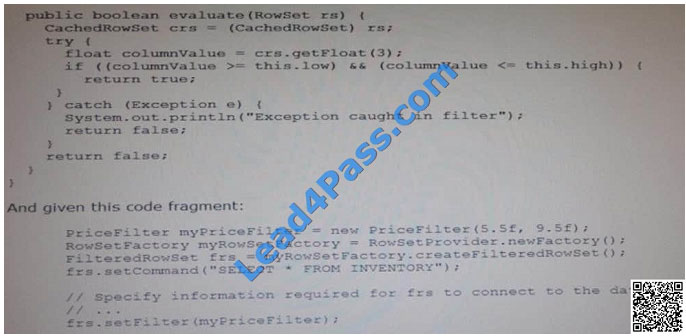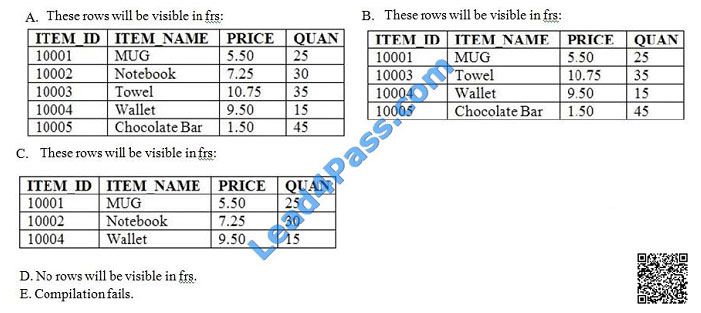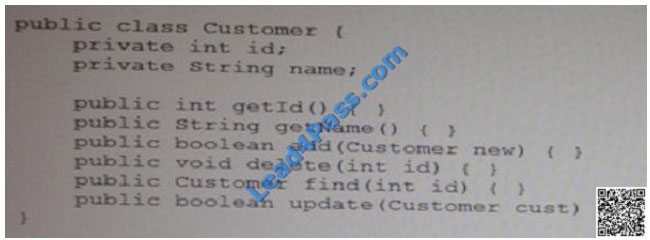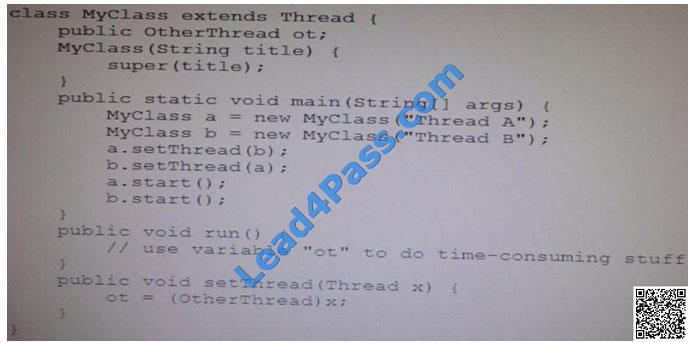Latest Oracle Java and Middleware 1Z0-804 exam dumps, 1Z0-804 exam Practice Test | 100% Free
We share the latest exam dumps throughout the year to help you improve your skills and experience! The latest Oracle Java and Middleware 1Z0-804 exam dumps, online exam Practice test to test your strength, Oracle 1Z0-804 “Oracle Certified Professional, Java SE 8 Programmer” in https://www.leads4pass.com/1z0-804.html Update the exam content throughout the year to ensure that all exam content is authentic and valid.
1Z0-804 PDF Online download for easy learning.
[PDF] Free Oracle Java and Middleware 1Z0-804 pdf dumps download from Google Drive: https://drive.google.com/open?id=1vSTdjODvxYV07E3Q2_sfnqczdYhI8vXJ
[PDF] Free Full Oracle pdf dumps download from Google Drive: https://drive.google.com/open?id=1MbUFUh0mnBLBvtc6SBd-ok4XLwRcYaqD
Java SE 8 Programmer II Certification Exam | 1Z0-809: https://education.oracle.com/java-se-8-programmer-ii/pexam_1Z0-809
Steps to Become an Oracle Certified Professional (OCP) Java SE 8 Programmer
To help you prepare for certification testing we recommend training and hands-on experience.
Step 1: Prepare to take the required OCP exam sequence by taking advanced Java SE 8 training and gaining practical, hands-on experience.
Step 2: Earn your Oracle Certified Associate (OCA) Java SE 8 Programmer credential by passing the Java SE Programmer I exam (1Z0-808).
Already an OCA or SCJP for Java SE 6 or prior and looking to upgrade?
Follow the Upgrade from Java SE 6 or prior to Java SE 8 certification path for guidance on certification requirements and which exam to take.
Already an OCA for Java SE 7 and looking to upgrade?
Follow the Upgrade from Java SE 7 to Java SE 8 certification path for guidance on certification requirements and the best exam to take.
Step 3: Take and pass the Java SE Programmer II exam (1Z0-809)
Free test Oracle Java and Middleware 1Z0-804 Exam questions and Answers
QUESTION 1
Given the following code fragment:
10.
p1 = paths.get(“report.txt”);
11.
p2 = paths.get(“company”);
12.
/ / insert code here
Which code fragment, when inserted independently at line 12, move the report.txt file to the company directory, at the
same level, replacing the file if it already exists?
A. Files.move(p1, p2, StandardCopyOption.REPLACE_EXISTING, StandardCopyOption.ATOMIC_MOVE);
B. Files.move(p1, p2, StandardCopyOption.REPLACE_Existing, LinkOption.NOFOLLOW_LINKS);
C. Files.move (p1, p2, StandardCopyOption.REPLACE_EXISTING, LinkOption.NOFOLLOW_LINKS);
D. Files.move(p1, p2, StandardCopyOption.REPLACE_EXISTING, StandardCopyOption.copy_ATTRIBUTES,
StandrardCopyOp)
E. Files.move (p1, p2 StandardCopyOption.REPLACE_EXISTING, StandardCopyOption.copy_ATTRIBUTES,
LinkOption.NOF)
Correct Answer: A
Moving a file is equally as straight forward ?move(Path source, Path target, CopyOption… options);
The available StandardCopyOptions enums available are:
StandardCopyOption.REPLACE_EXISTING
StandardCopyOption.ATOMIC_MOVE
If Files.move is called with StandardCopyOption.COPY_ATTRIBUTES an UnsupportedOperationException is thrown.
QUESTION 2
Given the code fragment: If the file userguide.txt does not exist, what is the result?
If the file userguide.txt does not exist, what is the result?
A. An empty file is created and success is printed.
B. class java.io.FileNotFoundException.
C. class java.io.IOException.
D. class java.lang.Exception.
E. Compilation fails.
Correct Answer: B
Note: public FileReader(String fileName) throws FileNotFoundException Creates a new FileReader, given the name of
the file to read from.
Parameters:
fileName – the name of the file to read from
Throws:
FileNotFoundException – if the named file does not exist, is a directory rather than a regular file, or for some other
reason cannot be opened for reading. Reference: java.io Class FileReader
QUESTION 3
Assuming the port statements are correct, which two code fragments create a one-byte file?
A. OutputStream fos = new FileOutputStream(new File(“/tmp/data.bin”)); OutputStream bos = new
BufferedOutputStream(fos); DataOutputStream dos = new DataOutputStream(bos); dos.writeByte(0); dos.close();
B. OutputStream fos = new FileOutputStream (“/tmp/data.bin”); dataOutputStream dos = new DataOutputStream(fos);
dos.writeByte(0); dos.close();
C. OutputStream fos = new FileOutputStream (new File (“/tmp/data.bin”)); dataOutputStream dos = new
DataOutputStream(os); dos.writeByte(0); dos.close();
D. OutputStream fos = new FileOutputStream (“/tmp/data.bin”); fos.writeByte(0); fos.close();
Correct Answer: BC
B: Create DataOutputStream from FileOutputStream public static void main(String[] args) throws Exception {
FileOutputStream fos = new FileOutputStream(“C:/demo.txt”); DataOutputStream dos = new DataOutputStream(fos);
Note:
The FileOutputStream class is a subclass of OutputStream.
You can construct a FileOutputStream object by passing a string containing a path name or a File object.
You can also specify whether you want to append the output to an existing file.
public FileOutputStream (String path)
public FileOutputStream (String path, boolean append)
public FileOutputStream (File file)
public FileOutputStream (File file, boolean append)
With the first and third constructors, if a file by the specified name already exists, the file will be overwritten. To append
to an existing file, pass true to the second or fourth constructor.
Note 2: public class DataOutputStream
extends FilterOutputStream
implements DataOutput
A data output stream lets an application write primitive Java data types to an output stream in a portable way. An
application can then use a data input stream to read the data back in.
Reference: java.io Class DataOutputStream
QUESTION 4
Given the two Java classes:
public class Word {
private Word(int length) {}
protected Word(String w) {}
}
public class Buzzword extends Word {
public Buzzword() {
// Line ***, add code here
}
public Buzzword(String s) {
super(s);
}
}
Which two code snippets, added independently at line ***, can make the Buzzword class compile?
A. this ();
B. this (100);
C. this (“Buzzword”);
D. super ();
E. super (100);
F. super (“Buzzword”);
Correct Answer: AF
QUESTION 5
Given the following code fragment:
public static void main(String[] args) {
Connection conn = null;
Deque myDeque = new ArrayDeque();
myDeque.add(“one”);
myDeque.add(“two”);
myDeque.add(“three”);
System.out.println(myDeque.remove());
}
What is the result?
A. Three
B. One
C. Compilation fails
D. The program runs, but prints no outout
Correct Answer: B
The ArrayDeque.remove() method retrieves and removes the head of the queue represented by this deque. The head of
the queue is item “one”. Reference: java.util Class ArrayDeque
QUESTION 6
Which is a factory method from the java.text.NumberFormat class?
A. format (long number)
B. getInstance()
C. getMaxiraumFractionDigits ()
D. getAvailableLocales ()
E. isGroupingUsed()
Correct Answer: B
To obtain a NumberFormat for a specific locale, including the default locale, call one of NumberFormat\\’s factory
methods, such as getInstance(). Reference: java.text Class DecimalFormat
QUESTION 7
Given the code fragment:
1.
path file = path.get (args.[0])
2.
try {
3.
} / / statements here
4.
catch (IOException) i ) {
5.
}
And a DOS-based file system:
Which option, containing statement(s), inserted at line 3, creates the file and sets its attributes to hidden and read-only?
A. DOSFileAttributes attrs = Files.setAttribute(file, “dos:hidden”, “dos: readonly”) Files.createFile(file, attrs)
B. Files.craeteFile(file); Files.setAttribute(file, “dos:hidden”, “dos:readonly”);
C. Files.createFile(file, “dos:hidden”, “dos:readonly”);
D. Files.createFile(file); Files.setAttribute(file, “dos:hidden”, true); Files.setAttribute(file, “dos:readonly”, true);
Correct Answer: D
You can set a DOS attribute using the setAttribute(Path, String, Object, LinkOption…) method, as follows:
Path file = …;
Files.setAttribute(file, “dos:hidden”, true);
Note:
setAttribute
public static Path setAttribute(Path path,
String attribute,
Object value,
LinkOption… options)
throws IOException
Sets the value of a file attribute.
Reference: Interface DosFileAttribute
QUESTION 8
Given:
class Plant {
abstract String growthDirection();
}
class Embryophyta extends Plant {
String growthDirection() { return “Up ” }
}
public class Garden {
public static void main(String[] args) {
Embryophyta e = new Embryophyta();
Embryophyta c = new Carrot();
System.out.print(e.growthDirection() +
A. growthDirection()); } } What is the result?
B. Up Down
C. Up Up
D. Up null
E. Compilation fails
F. An exception is thrown at runtime
Correct Answer: E
Exception in thread “main” java.lang.ExceptionInInitializerError at garden.Garden.main Caused by:
java.lang.RuntimeException: Uncompilable source code – garden.Plant is not abstract and does not override abstract
method growthDirection() in garden.Plant
QUESTION 9
Given:
import java.util.Map;
import java.util.Set;
import java.util.TreeMap;
public class MapClass {
public static void main(String[] args) {
Map partList = new TreeMap();
partList.put(“P002”, “Large Widget”);
partList.put(“P001”, “Widget”);
partList.put(“P002”, “X-Large Widget”);
Set keys = partList.keySet();
for (String key:keys) {
System.out.println(key + ” ” + partList.get(key));
}
}
}
What is the result?
A. p001 Widget p002 X-Large Widget
B. p002 Large Widget p001 Widget
C. p002 X-large Widget p001 Widget
D. p001 Widget p002 Large Widget
E. compilation fails
Correct Answer: A
Compiles fine. Output is: P001 Widget P002 X-Large Widget Line: partList.put(“P002”, “X-Large Widget”); overwrites
line: partList.put(“P002”, “Large Widget”);
QUESTION 10
Given the database table: And given this class:
And given this class:  Assume that the SQL integer queries are valid. What is the result of compiling and executing this code fragment? Refer
Assume that the SQL integer queries are valid. What is the result of compiling and executing this code fragment? Refer
to the exhibit.  A. A
A. A
B. B
C. C
D. D
E. E
Correct Answer: C
The code will compile now.
The three rows with PRICE in between 5.5 and 9.5 will be displayed.
QUESTION 11
Which statement declares a generic class?
A. public class Example { }
B. public class { }
C. public class Example { }
D. public class Example (Generic){ }
E. public class Example (G) { }
F. public class Example { }
Correct Answer: A
QUESTION 12
Given the code fragment: What change should you make to apply good coding practices to this fragment?
What change should you make to apply good coding practices to this fragment?
A. Add nested try-with-resources statements for the statement and Resulset declarations.
B. Add the statement and Resulset declarations to the cry-with-resources statement.
C. Add a finally clause after the catch clause.
D. Rethrow SQLException.
Correct Answer: C
The finally block always executes when the try block exits. This ensures that the finally block is executed even if an
unexpected exception occurs. But finally is useful for more than just exception handling — it allows the programmer to
avoid having cleanup code accidentally bypassed by a return, continue, or break. Putting cleanup code in a finally block
is always a good practice, even when no exceptions are anticipated.
QUESTION 13
Given the classes:
class Pupil {
String name = “unknown”;
public String getName() {return name;}
}
class John extends Pupil {
String name = “John”;
}
class Harry extends Pupil {
String name = “Harry”;
public String getName() {return name;}
}
public class Director {
public static void main(String[] args) {
Pupil p1 = new John();
Pupil p2 = new Harry();
System.out.print(p1.getName() + ” “);
System.out.print(p2.getName());
}
}
What is the result?
A. John Harry
B. unknown Harry
C. john unknown
D. unknown unknown
E. Compilation fails.
F. An exception is thrown at runtime.
Correct Answer: B
QUESTION 14
Which two are valid initialization statements?
A. Map m = new SortedMap();
B. Collection m = new TreeMap();
C. HashMap m = new SortedMap();
D. SortedMap m = new TreeMap ();
E. Hashtable m = new HashMap();
F. Map m = new Hashtable();
Correct Answer: DF
QUESTION 15
Given the code format:
SimpleDateFormat sdf;
Which code statements will display the full text month name?
A. sdf = new SimpleDateFormat (“mm”, Locale.UK); System.out.println(“Result: “, sdf.format(new date()));
B. sdf = new SimpleDateFormat (“MM”, Locale.UK); System.out.println(“Result: “, sdf.format(new date()));
C. sdf = new SimpleDateFormat (“MMM”, Locale.UK); System.out.println(“Result: “, sdf.format(new date()));
D. sdf = new SimpleDateFormat (“MMMM”, Locale.UK); System.out.println(“Result: “, sdf.format(new date()));
Correct Answer: D
Typical output would be Current Month in M format : 2 Current Month in MM format : 02 Current Month in MMM format :
Feb Current Month in MMMM format : February
QUESTION 16
The two methods of code reuse that aggregate the features located in multiple classes are ____________ .
A. Inheritance
B. Copy and Paste
C. Composition
D. Refactoring
E. Virtual Method Invocation
Correct Answer: AC
A: Inheritance is a way of reusing code and building bigger more functional objects from a basic object.
The original little object, the parent, is called the super-class. The more functional object that inherits from it is called the
sub-class .
C: When your goal is code reuse, composition provides an approach that yields easier-to-change code.
QUESTION 17
Given that myfile.txt contains:
First
Second
Third
Given the following code fragment:
public class ReadFile02 {
public static void main(String[] args) {
String fileName1 = “myfile.txt”;
String fileName2 = “newfile.txt”;
try (BufferedReader buffIn =
new BufferedReader(new FileReader(fileName1));
BufferedWriter buffOut =
new BufferedWriter(new FileWriter(fileName2))
) {
String line = “”; int count = 1;
line = buffIn.readLine();
while (line != null) {
buffOut.write(count + “: ” + line);
buffOut.newLine();
count++;
line = buffIn.readLine();
}
} catch (IOException e) {
System.out.println(“Exception: ” + e.getMessage());
}
}
}
What is the result?
A. new file.txt contains:
1: First
2: Second
3: Third
B. new file.txt contains:
1: First 2: Second 3: Third
C. newfile.txt is empty
D. an exception is thrown at runtime
E. compilation fails
Correct Answer: A
For each line in the file myfile.text the line number and the line is written into newfile.txt.
QUESTION 18
Given: What two changes should you make to apply the DAO pattern to this class?
What two changes should you make to apply the DAO pattern to this class?
A. Make the Customer class abstract.
B. Make the customer class an interface.
C. Move the add, delete, find, and update methods into their own implementation class.
D. Create an interface that defines the signatures of the add, delete, find, and update methods.
E. Make the add, delete, and find, and update methods private for encapsulation.
F. Make the getName and getID methods private for encapsulation.
Correct Answer: CD
C: The methods related directly to the entity Customer is moved to a new class.
D: Example (here Customer is the main entity):
public class Customer {
private final String id;
private String contactName;
private String phone;
public void setId(String id) { this.id = id; }
public String getId() { return this.id; }
public void setContactName(String cn) { this.contactName = cn;}
public String getContactName() { return this.contactName; }
public void setPhone(String phone) { this.phone = phone; }
public String getPhone() { return this.phone; }
}
1Z0-804 PDF Dumps | 1Z0-804 VCE Dumps | 1Z0-804 Practice Test 16 / 28https://www.leads4pass.com/1Z0-804.html
2019 Latest lead4pass 1Z0-804 PDF and VCE dumps Download
public interface CustomerDAO {
public void addCustomer(Customer c) throws DataAccessException;
public Customer getCustomer(String id) throws DataAccessException;
public List getCustomers() throws DataAccessException;
public void removeCustomer(String id) throws DataAccessException;
public void modifyCustomer(Customer c) throws DataAccessException;
}
Note: DAO Design Pattern
*
Abstracts and encapsulates all access to a data source
*
Manages the connection to the data source to obtain and store data
*
Makes the code independent of the data sources and data vendors (e.g. plain-text, xml, LDAP, MySQL, Oracle, DB2) 
QUESTION 19
Given:
import java.util.*;
public class CompareTest {
public static void main(String[] args) {
TreeSet set1 = new TreeSet(
new Comparator() {
public boolean compare(String s1, String s2) {
return s1.length() > s2.length();
}
});
set1.add(“peach”);
set1.add(“orange”);
set1.add(“apple”);
for (String n: set1) {
System.out.println(n);
}
}
}
What is the result?
A. peach orange apple
B. peach orange
C. apple orange
D. The program does not compile.
E. The program generates an exception at runtime.
Correct Answer: D
The compiler has a problem with the line:
public boolean compare(String s1, String s2) {
return s1.length() > s2.length();
error: is not abstract and does not override abstract method compare(String,String) in Comparator new Comparator() {
Error: compare(String,String) in cannot implement compare(T,T) in Comparator public boolean compare(String s1,
String s2) {
return type boolean is not compatible with int where T is a type-variable:
T extends Object declared in interface Comparator
QUESTION 20
Which four are true about enums?
A. An enum is typesafe.
B. An enum cannot have public methods or fields.
C. An enum can declare a private constructor.
D. All enums implicitly implement Comparable.
E. An enum can subclass another enum.
F. An enum can implement an interface.
Correct Answer: ACDF
C: The constructor for an enum type must be package-private or private access. Reference: Java Tutorials, Enum
Types
QUESTION 21
Given:
public class MarkOutOfBoundsException extends ArrayIndexOutOfBoundsException {
public class Test {
public void verify(int[] arr)
throws ArrayIndexOutOfBoundsException {
for (int i = 1; i 100)
throw new MarkOutOfBoundsException();
System.out.println(arr[i]);
}
}
public static void main(String[] args) {
int[] arr = {105,78,56};
try {
new Test().verify(arr);
} catch (ArrayIndexOutOfBoundsException |
MarkOutOfBoundsException e) {
System.out.print(e.getClass());
}
}
}
What is the result?
A. Compilation fails.
B. 78 class java.lang.Array.IndexOutOfBoundException
C. class MarkOutOfBoundException
D. class java.lang.arrayIndexOutOfBoundException
Correct Answer: A
QUESTION 22
Given the code fragment:
public void infected() {
System.out.print(“before “);
try {
int i = 1/0;
System.out.print(“try “);
} catch(Exception e) {
System.out.print(“catch “);
throw e;
} finally {
System.out.print(“finally “);
}
System.out.print(“after “);
}
What is the result when infected() is invoked?
A. before try catch finally after
B. before catch finally after
C. before catch after
D. before catch finally
E. before catch
Correct Answer: C
The following line throws and exception: int i = 1/0;
This exception is caught by: catch(Exception e) { System.out.print(“catch “); throw e;
Lastly, the finally statement is run as the finally block always executes when the try block exits. This ensures that the
finally block is executed even if an unexpected exception occurs.
Reference: Java Tutorial, The finally Block
QUESTION 23
Given:
public class StringSplit01 {
public static void main(String[] args) {
String names = “John-.-George-.-Paul-.-Ringo”;
String[] results = names.split(“-. .”);
for(String str:results) {
System.out.println(str);
}
}
}
What is the result?
A. John?. -George-. ?Paul -. ?Ringo
B. John George Paul Ringo
C. John George
Paul Ringo
D. An exception is thrown at runtime
E. Compilation fails
Correct Answer: B
The split() method is used to split a string into an array of substrings, and returns the new array.
QUESTION 24
Given:
public class Print01 {
public static void main(String[] args) {
double price = 24.99;
int quantity = 2;
String color = “Blue”;
// insert code here. Line ***
}
}
Which two statements, inserted independently at line ***, enable the program to produce the following output:
We have 002 Blue pants that cost $24.99.
A. System.out.printf(“We have %03d %s pants that cost $%3.2f.\n”, quantity, color, price);
B. System.out.printf(“We have $03d $s pants that cost $$3.2f.\n”, quantity, color, price);
C. String out = String.format (“We have %03d %s pants that cost $%3.2f.\n”, quantity, color, price);
System.out.println(out);
D. String out = System.out.format(“We have %03d %s pants that cost $%3.2f.”, quantity, color, price);
System.out.println(out);
E. System.out.format(“We have %s %s pants that cost $%s.\n”, quantity, color, price);
Correct Answer: AC
QUESTION 25
Given the code fragment:
public class IsContentSame {
public static boolean isContentSame() throws IOException {
Path p1=Paths.get(“D:\\faculty\\report.txt”);
Path p2=Paths.get(“C:\\student\\report.txt”);
Files.copy(p1,p2,StandardCopyOption.REPLACE_EXISTING,StandardCopyOption.COPY_
ATTRIBUTES,LinkOption.NOFOLLOW_LINKS);
if(Files.isSameFile(p1,p2)) {
return true;
} else {
return false;
}
}
public static void main(String[] args) {
try {
boolean flag = isContentSame();
if(flag)
System.out.println(“Equal”);
else
System.out.println(“Not equal”);
} catch (IOException e) {
System.err.println(“Caught IOException: ” + e.getMessage());
}
}
}
What is the result when the result.txt file already exists in c:\student?
A. The program replaces the file contents and the file\\’s attributes and prints Equal.
B. The program replaces the file contents as well as the file attributes and prints Not equal.
C. An unsupportedoperationException is thrown at runtime.
D. The program replaces only the file attributes and prints Not equal.
Correct Answer: C
Assuming there is a file D:\\faculty\\report.txt then this file will be copied and will be replacing C:\\student\\report.txt.
QUESTION 26
Given the code fragment:
SimpleDataFormat sdf;
Which code fragment displays the three-character month abbreviation?
A. SimpleDateFormat sdf = new SimpleDateFormat (“mm”, Locale.UK); System.out.println (“Result:” + sdf.format(new
Date()));
B. SimpleDateFormat sdf = new SimpleDateFormat (“MM”, Locale.UK); System.out.println (“Result:” + sdf.format(new
Date()));
C. SimpleDateFormat sdf = new SimpleDateFormat (“MMM”, Locale.UK); System.out.println (“Result:” + sdf.format(new
Date()));
D. SimpleDateFormat sdf = new SimpleDateFormat (“MMMM”, Locale.UK); System.out.println (“Result:” +
sdf.format(new Date()));
Correct Answer: C
Output example: JUN
QUESTION 27
Which statement creates a low overhead, low-contention random number generator that is isolated to thread to
generate a random number between 1 and 100?
A. int i = ThreadLocalRandom.current().nextInt(1, 101);
B. int i = ThreadSafeRandom.current().nextInt(1, 101);
C. int i = (int) Math.random()*100+1;
D. int i = (int) Math.random(1, 101);
E. int i = new random().nextInt(100)+1;
Correct Answer: A
public class ThreadLocalRandom
extends Random\\’
A random number generator isolated to the current thread. Like the global Random generator used by the Math class, a
ThreadLocalRandom is initialized with an internally generated seed that may not otherwise be modified. When
applicable, use of ThreadLocalRandom rather than shared Random objects in concurrent programs will typically
encounter much less overhead and contention. Use of ThreadLocalRandom is particularly appropriate when multiple
tasks (for
example, each a ForkJoinTask) use random numbers in parallel in thread pools.
Usages of this class should typically be of the form:
ThreadLocalRandom.current().nextX(…) (where X is Int, Long, etc). When all usages are of this form, it is never possible
to accidently share a ThreadLocalRandom across multiple threads.
This class also provides additional commonly used bounded random generation methods.
Reference: Class ThreadLocalRandom
QUESTION 28
Given the fragment: If thread a and thread b are running, but not completing, which two could be occurring?
If thread a and thread b are running, but not completing, which two could be occurring?
A. livelock
B. deadlock
C. starvation
D. loose coupling
E. cohesion
Correct Answer: AB
A: A thread often acts in response to the action of another thread. If the other thread\\’s action is also a response to the
action of another thread, then livelock may result. A thread often acts in response to the action of another thread. If the
other thread\\’s action is also a response to the action of another thread, then livelock may result.
B: Deadlock describes a situation where two or more threads are blocked forever, waiting for each other.
QUESTION 29
Sam has designed an application. It segregates tasks that are critical and executed frequently from tasks that are non
critical and executed less frequently. He has prioritized these tasks based on their criticality and frequency of execution.
After close scrutiny, he finds that the tasks designed to be non critical are rarely getting executed.
From what kind of problem is the application suffering?
A. race condition
B. starvation
C. deadlock
D. livelock
Correct Answer: C
Starvation describes a situation where a thread is unable to gain regular access to shared resources and is unable to
make progress. This happens when shared resources are made unavailable for long periods by “greedy” threads. For
example, suppose an object provides a synchronized method that often takes a long time to return. If one thread
invokes this method frequently, other threads that also need frequent synchronized access to the same object will often
be blocked.
Reference: The Java Tutorial, Starvation and Livelock
QUESTION 30
To provide meaningful output for:
System.out.print( new Item ()):
A method with which signature should be added to the Item class?
A. public String asString()
B. public Object asString()
C. public Item asString()
D. public String toString()
E. public object toString()
F. public Item toString()
Correct Answer: D
Implementing toString method in java is done by overriding the Object\\’s toString method. The java toString() method is
used when we need a string representation of an object. It is defined in Object class. This method can be overridden to
customize the String representation of the Object.
Note:
Below is an example shown of Overriding the default Object toString() method. The toString() method must be
descriptive and should generally cover all the contents of the object.
class PointCoordinates {
private int x, y;
public PointCoordinates(int x, int y) {
this.x = x;
this.y = y;
}
public int getX() {
return x;
}
public int getY() {
return y;
}
// Custom toString() Method.
public String toString() {
return “X=” + x + ” ” + “Y=” + y;
}
}
We share 30 of the latest Oracle Java and Middleware 1Z0-804 exam dumps and 1Z0-804 pdf online download for free. Now you know what you’re capable of! If you’re just interested in this, please keep an eye on “Makeexams.com” blog updates! If you want to
get the Oracle Java and Middleware 1Z0-804 Exam Certificate: https://www.leads4pass.com/1z0-804.html (Total questions:150 Q&A).
Related 1Z0-804 Exam Resources
| title | youtube | Java SE 8 Programmer II Certification Exam | 1Z0-809 | lead4pass | |
|---|---|---|---|---|
| cisco 1Z0-804 | lead4pass 1Z0-804 dumps pdf | lead4pass 1Z0-804 youtube | Java SE 8 Programmer II Certification Exam | 1Z0-809 | https://www.leads4pass.com/1z0-804.html |
| Oracle Java and Middleware | https://www.leads4pass.com/1z0-151.html | |||
| https://www.leads4pass.com/1z0-419.html | ||||
| https://www.leads4pass.com/1z0-803.html | ||||
| https://www.leads4pass.com/1z0-807.html | ||||
| https://www.leads4pass.com/1z0-808.html | ||||
| https://www.leads4pass.com/1z0-809.html |
Lead4pass Promo Code 12% Off

Why Choose Lead4pass?
Lead4Pass helps you pass the exam easily! We compare data from all websites in the network, other sites are expensive,and the data is not up to date, Lead4pass updates data throughout the year. The pass rate of the exam is above 98.9%.
